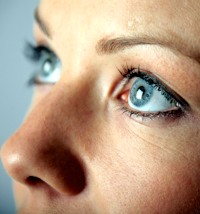New research finds acupuncture more effective than medications for the treatment of a sty (hordeolum), a red lump near the edge of the eyelid.  A total of 102 sty patients participated in the study. They were randomized into two separate groups. Group 1 received acupuncture and group 2 was given local applications of the antibiotics levofloxacin and erythromycin. Both groups also received the application of a warm compress to the affected eyelid.
A total of 102 sty patients participated in the study. They were randomized into two separate groups. Group 1 received acupuncture and group 2 was given local applications of the antibiotics levofloxacin and erythromycin. Both groups also received the application of a warm compress to the affected eyelid.
Comparisons were made in pain reduction and swelling size reduction. All investigators evaluating the improvements did not know which group each patient participated in as a measure to avoid bias. On day 3 after treatment, the acupuncture group showed a 64.7% improvement and the medication group showed a 41.2% improvement. On day 5, the acupuncture group demonstrated a 90.2% improvement and the medication group showed a 62.7% improvement. On day 7, the acupuncture group demonstrated a 94.1% improvement and the medication group showed an 80.4% improvement. The researchers concluded that the data showed that acupuncture produced superior results to medications for the treatment of a sty. They noted that acupuncture for the treatment of an external sty is effective for the relief of pain and reduction of sty size. The researchers also note that acupuncture shortens the duration of the disease.
Getting to the Point
The only acupuncture point used in the study was Erjian (Tip of the Ear, M-HN-10). This acupuncture point is located by folding the ear forward and is then found at the apex of the outer ear at the upper helix. The folding technique involves covering the posterior aspect of the upper helix over the anterior aspect such that the posterior aspect covers the anterior aspect of the upper helix entirely. The investigators chose to use the bleeding technique and removed between 5 and 6 drops of blood each treatment from Erjian.
The first historical record of the Erjian’s use comes from the Ming Dynasty. The great scholar Yang Ji Zhou covered its use for the treatment of superficial visual obstructions by stimulation with moxibustion in the Traditional Chinese Medicine (TCM) classic work The Great Compendium of Acupuncture and Moxibustion. Since its very first mention, Erjian has been ascribed the functions of clearing heat, dissipating swelling and benefitting the eyes and throat. Traditional indications for the use of Erjian are redness, swelling and pain of the eyes. In addition, superficial visual obstructions, throat pain and swelling, unilateral headache, fever and mumps are indicated.
Reference:
Qi, H. F., J. F. Zhao, Y. Wang, and X. Y. Chen. "[Randomized controlled clinical trials for treatment of external sty with ear-apex blood-letting]." Zhen ci yan jiu= Acupuncture research/[Zhongguo yi xue ke xue yuan Yi xue qing bao yan jiu suo bian ji] 38, no. 2 (2013): 148-151.

